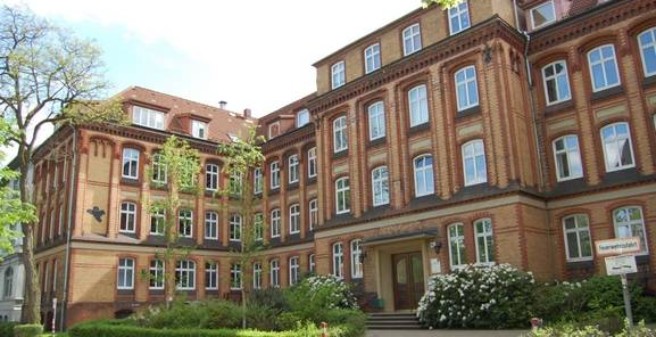Center for Bioinformatics Hamburg
The Center for Bioinformatics (ZBH) of the University of Hamburg was established on July 1, 2002 by the Faculty of Mathematics, Informatics and Natural Sciences (MIN) and the Faculty of Medicine.
Above all, research in bioinformatics means developing computer models and tools for the prediction of molecular properties and phenomena in life sciences. The three research groups and two junior research groups at the ZBH work on problems in the areas of genomics, structural biology and drug design. Computer programs developed at the ZBH are used worldwide both in academic institutions and industry. The three research groups and two junior research groups work on basic and applied topics.
Bioinformatics - the application of methods from informatics to scientific problems of life sciences - has become a key technology in the 21st century. The computer has become an integral part of modern molecular biological and pharmaceutical research. Research in life sciences is characterized by high-throughput experiments, for example sequencing of complete genomes, protein structure determination, expression profile determination, or measuring molecular interactions between biomolecules. These experiments result in large volumes of complex data. Bioinformatics plays a key role in this context by supplying the appropriate software tools for analyzing, evaluating and interpreting this data.
The research at the Center for Bioinformatics Hamburg (ZBH) covers the following main fields of Bioinformatics:
- storage, analysis and interpretation of genomes and proteomes
- protein structure prediction and protein design
- computer-aided molecular design and chemoinformatics
- • Speicherung, Analyse und Interpretation von Genomen und Proteomen
• Proteinstrukturvorhersage und Proteindesign
• Computer-gestütztes Design von Molekülen und Chemoinformatik
-
Genome informatics
Genome Informatics
The Research Group for Genome Informatics works on methods for the efficient storage and retrieval of large amounts of sequence data. Based on these methods, software tools for comparing complete genomes and for prediction of functional elements like gene structures and repetitive sequences are developed. The group is also involved in service-oriented data evaluation and visualization projects. Possible areas for collaborations are- Development of individual Data management systems
- Sequence based analysis of repetitive structures and structure variants in the human genome
-
Biomolecular Modelling
Biomolecular Modeling
For the prediction of shape and function of large biomolecules such as proteins and nucleic acids one needs mathematical models. The Research Group for Biomolecular Modeling builds models to help understand molecular processes or even predict how molecules will behave within their natural environment. Possible areas for collaborations are:- remote protein relationships, sequence, structural, functional
- RNA and Protein design and modelling.
Please contact Prof. Dr. Andrew Torda (Telephone: +49 (40) 42838 7331).
-
Computational Molecular Design
Computational Molecular Design
Compute aided molecular design and molecular modeling address, among other things, the development of compounds such as pharmaceuticals showing effects in biological systems. The Research Group for Computational Molecular Design develops and implements new computational methods in this field and uses the resulting software tools in specific application studies. Possible areas for collaborations are:- design of and virtual high throughput screening of potential therapeutics
- management, analysis and visualization of small molecule libraries
Please contact Prof. Dr. Matthias Rarey (Telephone: +49 (40) 42838 7351).
-
Theoretical and Computational Chemistry
Many chemical questions can not be answerer (or only with very high efforts) in an experimeltal way. In these cases the theoretical chemistry provides the possibility to find answers with mathematical models. These mathematical models try to depict the physics of the analyzed systems in a very detailed fashion, so that direct insights into the characteristics and processes are possible. Therefore, the theroretical chemistry, often in conjunction with expreimental works, expands our understanding of chemistry.
Pleasr contact Prof. Dr. Tobias Schwabe (Telephone: +49 (40) 42838 7333).
-
Applied Cheminformatics and Molecular Design
Today a wide array of computational methods is complementing experimental efforts in discovering new, bioactive molecules, including drugs, agrochemicals, functional foods and cosmetics. Research and application of these methods is driven by an urgent need to make drug development more efficient and scale down animal experiments to a non-reducible minimum.
This lab focuses on the research of novel computational approaches in early stage drug development (the lead identification and optimisation phases). There is a particularly interest in developing accurate models for the prediction of metabolism, which is a key factor for the safety and performance of any chemicals in contact with an organism. Further, cooperations with a larger number of projects, together with on-site, national and international teams of experimentalists, are established. Aims are the use of computational methods to identify and optimise bioactive compounds for innovative drug targets, such as inhibitors of protein-protein interactions or chemical chaperones that cure diseases involving misfolded proteins. These projects often include the virtual screening of large natural products databases for promising plant constituents, which are then extracted, purified, and experimentally evaluated by the collaborators. These results are then used to optimise prediction methods and models, hence closing the development cycle.
- Prediction of xenobiotic metabolism and (eco-) toxicity
- Design and identification of innovative bioactive compounds
- Natural products research
Please contact Prof. Dr. Johannes Kirchmair (Telephone: +49 (40) 42838 7303).
